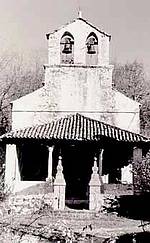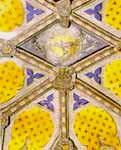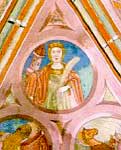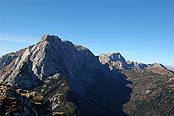The Votive Chapels of the Natisone Valleys

Extracted from Chiesette votive da S. Pietro al Natisone a Prepotto (votive chapels from S. Pietro al Natisone to Prepotto)
Tarcisio Venuti
published by La Nuova Base 1985
Votive chapels are widely distributed over the territories of the Natisone Valleys and the Judrio Valley. Typically they date from the 15th and 16th Centuries, and occupy sites on hilltops, on rocky prominences, near medieval remains or, less commonly, near villages. They were generally erected in isolated locations away from human settlements where they were more secure from depredation in a region that had been repeatedly invaded from the earliest years of the Christian era.
It should probably be emphasised that the term votive is almost always used improperly, at least in the meaning that we nowadays attach to it, inasmuch as they are normally indicated as rural or mountain churches during pastoral visits.
These chapels display characteristic transalpine architectural influences, notably the Slovenian Gothic style of the so called Masters of Skofja Loka, especially Andrea of Skofja Loka, known above all for his association with the church and cave of San Giovanni d’Antro.
A distinctive feature is the polygonal apses with ceilings that are sometimes decorated in a lozenge pattern by a network of stone or plaster tracery.
These small chapels are memorable for another important artistic feature, namely the lavishly decorated 16th and 17th Century wooden altars (the zlati oltar) produced in the workshops of Caporetto, which also operated in and around Cividale during the baroque period.
An important element of the cultural and artistic inheritance of the Natisone Valleys.
Some example
The Chapel of San Giacomo Apostolo

Biacis - Pulfero
The chapel of San Giacomo is thought to have belonged to the Antro castle that was built nearby, and therefore to date originally back to the 12th or 13th Centuries. The current chapel dates back to the early 16th Century, possibly 1520, with restoration work dating back to 1753.
It is known to have been rebuilt after the earthquakes of 1511-13.
The Chapel of San Giovanni Battista

Antro - Pulfero
Situated among the cliffs of an impressively picturesque landscape at a height of 348 metres above sea level is the famed cave sanctuary of Antro, the most important natural, historical and religious monument of the Natisone Valleys. In fact, the Cave of San Giovanni d’Antro holds as much artistic interest as speleological. Antro, which was attracting hermits in the Longobard era, is recorded in a palaeochristian document of 888 AD. The chapel is the work of the master Andrej von Lach, who began the reconstruction of the earlier 12th or 13th Century chapel in 1477, while the early 16th Century wooden altar in the great Cave is by the master Bartolomio Ortari of Caporetto.
The Chapel of San Bartolomeo

Vernasso - S. Pietro al Natisone
The chapel stands in the village of Goregnis, a few hundred metres from Vernasso, and dates back to the second half of the 15th Century. A series of paintings discovered during recent restoration work indicates that the presbytery was redecorated around 1530, since the frescoes are by Jernej da Loka (Bartolomeo of Skofja Loka), who was working in the area at that time. The choir contains a wooden altar of complex design, dated 1689, the work of the master carver Bartolomio Ortari (Jernej Vrtav) of Caporetto
The Chapel of San Quirino
San Pietro al Natisone
The chapel of San Quirino, the oldest in the parish, is located on the outer edge of the built area of San Pietro al Natisone, on the site of a prehistoric necropolis. It is known that a church was built in San Quirino in 1250, and the market was mentioned in 1254.
The Arengo (Assembly) of the Venetian Slovenia used to meet near this chapel.
The ceiling contains figures in ornamental relief and representations of saints within a decorated network tracery.
The coats of arms of Cividale and the Gastaldia (the Longobard administrative office) of Antro can also be seen in the ceiling tracery.
The Chapel of San Antonio Abate

Clenia – San Pietro al Natisone
The chapel of San Antonio Abate is in Clenia, the village immediately following Azzida, on the left hand side of the road leading to Savogna. It was probably founded in the 14th Century. Following the earthquakes of 1511-1513, the apse was reconstructed to the style of the school of master Andrea from Skofja Loka. The altar belongs to the group of gilded altars (zlati oltar).
The Chapel of San Mattia Apostolo

Costne - Grimacco
Costne is a hamlet in the Municipality of Grimacco located in the upper Cosizza basin and reached by the twisting road from Clodig. The chapel stands on a hill, and is thought to be from the late Romanesque period (14th-15th Centuries) and to have been reconstructed in the early 16th Century following the earthquakes of 1511-13. Later restoration work was carried out in the 18th and 19th Centuries. The bell tower, with its triple-mullioned windows, is of recent construction.
The Chapel of San Antonio of Bergagna

Merso di Sopra – San Leonardo
The chapel is sited on the brow of a small mound at the start of the ridge that divides the Cosizza and Erbezzo valleys near the hamlet of Merso di Sopra. It was the headquarters of the Magistracy of Merso, similar to that of Antro, with which it jointly formed the Arengo (Assembly). The Capitolo di Cividale archive contains the chapel’s foundation deed, dated 11 February 1441. The deeds relating to the construction works reveal that the site fell under the jurisdiction of Cividale’s Monastery of Santa Maria in Valle. The interior contains some fragments of 15th Century frescoes that were seriously damaged during reconstruction work in 1795.
The Chapel of Santa Lucia Vergine e Martire

Cravero – San Leonardo
A steep winding road from Merso di Sopra leads to the hamlet of Cravero, at the far end of which stands the chapel of Santa Lucia. It was erected in 1454 and subsequently reconstructed after the disastrous earthquakes of 1511-13. The ceiling of the apse is entirely frescoed with keystones showing shields and rosettes in a tracery network, attributed to the painter Jernej of Skokja Loka (Jernej iz Loke) or to one of his pupils. The richly decorated 18th century gilded altar is the work of Lukas Sharf.
The Chapel of San Nicolò

Jainich – San Leonardo
The chapel of San Nicolò stands alongside the scenic road between Castelmonte and Tribil di Sopra. It is of ancient 13th Century origin, the precise foundation date being 1294. The original Romanesque chapel was modified with Gothic additions in 1450 and subsequently restructured in 1525 or 1526 after the earthquakes of 1511-1513. It attained its present form towards 1700 with the addition of the front porch. Restoration work in 1959 revealed three terracotta reliquaries of great historical importance to the study of Episcopal consecration seals.
The Chapel of San Tommaso Apostolo

Codromaz - Prepotto
The chapel of San Tommaso lies at the end of the Judrio valley in the hamlet of Codromaz, It was probably erected in 1480, with reconstruction work after the earthquakes of 1511-1513, while the apse was added around 1530. When the exterior facade was restored some decades ago, the portico and the bell tower with its double-mullioned windows were eliminated. The presbytery has a polygonal shape and a ribbed vault surmounted by a lancet triumphal arch.
The Chapel of Santi Pietro e Paolo
Albana - Prepotto
The chapel was constructed during the late 15th Century, although there may have been an earlier one a century or so previously, given the age of the village in which it is located. It was radically changed in the first half of the 16th Century after the earthquakes of 1511-1513, with the choir being remodelled in the Slovenian style of the Skofja Loka masters. Its abundance of statuettes has no parallel in other chapels of the region. The wooden altar is of particular interest, being in a style reminiscent of the Slovenian zlati oltar school, although it is probably of Gorizian origin. Further restoration work was carried out in the 18th Century.
The Chapel of San Pietro Apostolo

Chiazzacco - Prepotto
San Pietro di Chiazzacco is a hamlet occupying the slopes of the hill that separates the Judrio and Chiarò valleys. It was recorded as far back as 1178 under the name of Casago. The original chapel was of extremely ancient origin and may have been the oldest in the area, having been consecrated after the year 1000. The current building dates back to the late 15th Century. Important 14th Century frescoes of the Slovenian school decorate the vault and ceiling of the presbytery and the triumphal facade.
The Chapel of Santi Ermacora e Fortunato
Cialla - Prepotto
Cialla is a small village in the Chiarò river valley, recorded in 1203 as Ciala. The chapel, which lies at the rear of the village, was constructed in the late 14th or early 15th Century. It was reconstructed in a manner closer to the Slovenian style after the earthquakes of 1511-1513. From its foundation it was subordinate to the parish of San Martino in Cividale. Worship of the patron saints of the Aquileia Patriarchate has ancient roots in Friuli.







